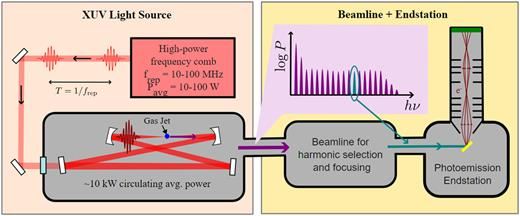High-order harmonic generation (HHG) plays a crucial role in producing coherent extreme ultraviolet (XUV) and soft X-ray light. However, traditional HHG techniques struggle with low efficiency, limiting their practical applications. The recent advancement of cavity enhancement is changing this landscape, providing a powerful way to amplify laser intensity and unlock new scientific potential.

Sketch of layout for a CE-HHG-based photoemission apparatus. The pulse train from a high-power frequency comb laser is resonantly enhanced in a “bow-tie” style cavity with a small focus. A broad range of high-order harmonics is generated at > 10 MHz repetition rate and outcoupled from the cavity; the figure is deliberately agnostic as to the outcoupling method since several methods exist.1 For experiments with high spectral resolution, a single harmonic is selected with an XUV beamline and delivered to an endstation for photoelectron spectroscopy.
Inside the Cavity: How Enhancement Works
Cavity-enhanced HHG relies on a high-finesse optical cavity, which traps and recirculates laser pulses. This setup causes the pulses to constructively interfere, dramatically raising their intensity at the point where they interact with a gas medium. As a result, even low-energy lasers operating at high repetition rates can efficiently generate high-order harmonics while maintaining the phase coherence required for advanced experiments.
- Optical cavities use constructive interference to multiply laser intensity.
- Pulse recirculation supports the use of modest laser energies for high photon yields.
- Coherence is preserved, enabling precise spectroscopy and measurement.
Scientific Breakthroughs and Technological Impacts
The ability to generate bright, coherent XUV and soft X-ray sources with tabletop systems is transforming research. Cavity-enhanced HHG is enabling:
- Attosecond science experiments without relying on massive synchrotron or free-electron laser facilities
- Greater precision in atomic, molecular, and optical physics studies
- Advanced time-resolved experiments, capturing ultrafast processes with unprecedented detail
This means scientists can now observe electron motion and chemical reactions as they happen—essential for breakthroughs in fields like quantum dynamics and ultrafast chemistry.
Overcoming Technical Barriers
Implementing cavity-enhanced HHG comes with challenges, especially around maintaining phase matching and protecting optics from high-intensity damage. Recent innovations are addressing these issues through:
- Careful cavity and mirror design to withstand intense light
- Precision feedback systems to stabilize cavity length and laser frequency
- Optimized gas jet placement to maximize harmonic generation and minimize distortion
Expanding Applications
The improved performance of cavity-enhanced HHG is opening new avenues across multiple disciplines. Notable applications include:
- Frequency comb spectroscopy: High-repetition XUV sources deliver ultra-precise spectroscopic data.
- Coherent diffractive imaging: Enhanced harmonics make high-resolution imaging of nanostructures and biomolecules possible.
- Quantum material research: Ultrafast pulses probe hidden electronic and magnetic behaviors in advanced materials.
Future Directions and Takeaway
Research into cavity-enhanced HHG continues to push boundaries, focusing on boosting efficiency, expanding wavelength coverage, and improving robustness. As these systems become more accessible, they are set to democratize advanced XUV and soft X-ray science, making ultrafast experiments possible in a broader range of labs.
Conclusion
Cavity-enhanced HHG allows for effective generation of coherent short-wavelength light. By amplifying laser pulses within optical cavities, scientists are now equipped to explore ultrafast physical and chemical dynamics, paving the way for groundbreaking discoveries in multiple fields.

Cavity-Enhanced High-Order Harmonic Generation: Transforming XUV and Attosecond Science